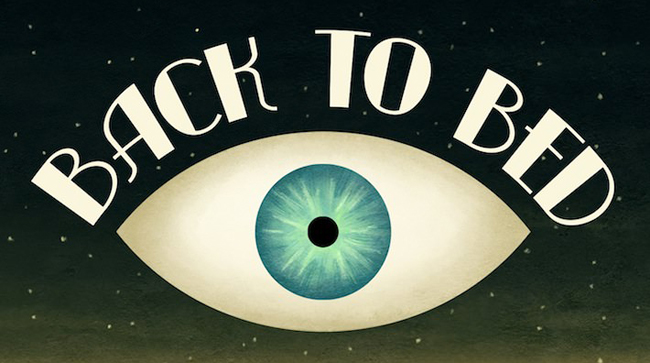
I may have gotten a C+ in Visual Arts at high school, but I have still always maintained a deep appreciation for the finer arts. Most notably, my favourite body of work is from the infamous artist Edvard Munch whose style carried psychological and dark themes across all of his paintings. When I first caught word about Back to Bed, by the fittingly named Bedtime Digital Games, the appeal in its surrealistic approach immediately caught my attention.
Back to Bed is an imaginative 3D isometric puzzler that is set in a dreamscape world. In this bizarre realm are some iconic elements from well-known paintings such as the melting clock from ‘The Persistence of Memory’, and an approach to level design that’s clearly influenced by ‘Relativity’ by M.C. Escher – It all makes for an exciting backdrop!

The story starts with Bob, a narcoleptic office worker, who has unfortunate episodes of falling asleep while at the office; due in part to his boring line of work. The problem, however, is that Bob is a sleepwalker, which often puts him into the dangerous surroundings of the busy city. As luck would have it, Bob has a subconscious protector named Subob, a human-faced dog-like creature created from Bob’s mind. Subob’s one job is to protect the sleepwalker from the hazards of his dream-world and guide him safely back to bed. The tale is simple to comprehend, but provides a somewhat enigmatic and mysterious feeling as you play through the game.
Back to Bed follows a straightforward rule, in which anytime Bob bumps into an object or wall, he turns clockwise. This concept helps you plan his path ahead of time and definitely gives your brain a bit of a workout. At the beginning of the level, the whole stage is in full view which gives you a good impression on how to get Bob to bed. However, in later stages, the playing field progressively increases in size, which means memorising the platforms becomes an imperative factor. In addition, with each new stage, the platforms grow increasingly narrow and more difficult to navigate; thus, shrinking the space for Bob and Subob to co-exist. With that being said, I still felt that it could have benefitted from additional levels, allowing the size of the stages to get just that little bit bigger and more challenging.

The gameplay in Back to Bed is simple, but it’s arguably better suited to a gamepad. You take control of Subob, who must create a safe path for Bob to arrive soundly back to his bed. It is essential a point A to B puzzle game which is easy to grasp for even the most casual gamer. The inverted stairways and walls might confuse at first, but you’ll soon realise that it’s just for creativity’s sake and not something you can walk on. What’s also great is that there’s more than one way for to solve each stage, which subsequently provides an opportunity to be creative in your approach.
In order to stop Bob from plummeting to his death, Subob has to pick up and place items to help keep him walking in the right direction. Some of these items include giant green apples which can be placed to re-direct his course, as well as long fish which can be used as bridges. Noted, there are also obstacles that will wake and harm Bob on his way to bed, such as alarm clocks and aggressive dogs; it is no easy task to get Bob to slumber-town, but it’s a lot of fun.

The presentation of Back to Bed is both imaginative and spectacular to look at, with a design which employs a distinct influence from M.C. Escher’s work. Each of the levels are well detailed with surreal items, exhibiting floating bowler hats, inverted walkways to sea calms, and hovering chess pieces; each of which adds a unique touch to this strange and compelling experience. The character design to Bob and Subob remain authentic to the surreal theme; with the animation providing appealing personalities to the quiet heroes. The soundtrack further enhances the style with its calming, and at times, mesmerizing tones. Lastly, to top off an already bizarre natured game; the narrator truly shines with his eerie reversed sounding voice that provides you with some helpful hints in selected stages.
 Picturesque visuals create a unique world
Picturesque visuals create a unique world
 Isometric level design is well implimented
Isometric level design is well implimented
 Illustrious paintings add a sense prestige
Illustrious paintings add a sense prestige
 Challenging puzzles seldom grow frustrating
Challenging puzzles seldom grow frustrating
 A bit short – could have used 30 more levels
A bit short – could have used 30 more levels
 Later stages could have been a bit bigger
Later stages could have been a bit bigger
It only took two hours to complete Back to Bed, which, unfortunately, felt short-lived and left me wanting more. It did, however, offer a new mode called “nightmare, but it’s basically the same 30 levels with an additional key to try and locate. In truth, the game does feel as if it really could have been twice as long, utilising more puzzles and stage styles to provide a full satisficing game length. With that being said, overall, the game is still a clever little puzzler with an artful flavour that will make your night-in memorable. The cut scenes in-between levels are a marvel to watch; stringing the whole adventure together into one neat dreamlike package. If you’re looking for a short game with some thought-provoking and interesting visuals, then Back to Bed is the game that you’ve been dreaming of.











